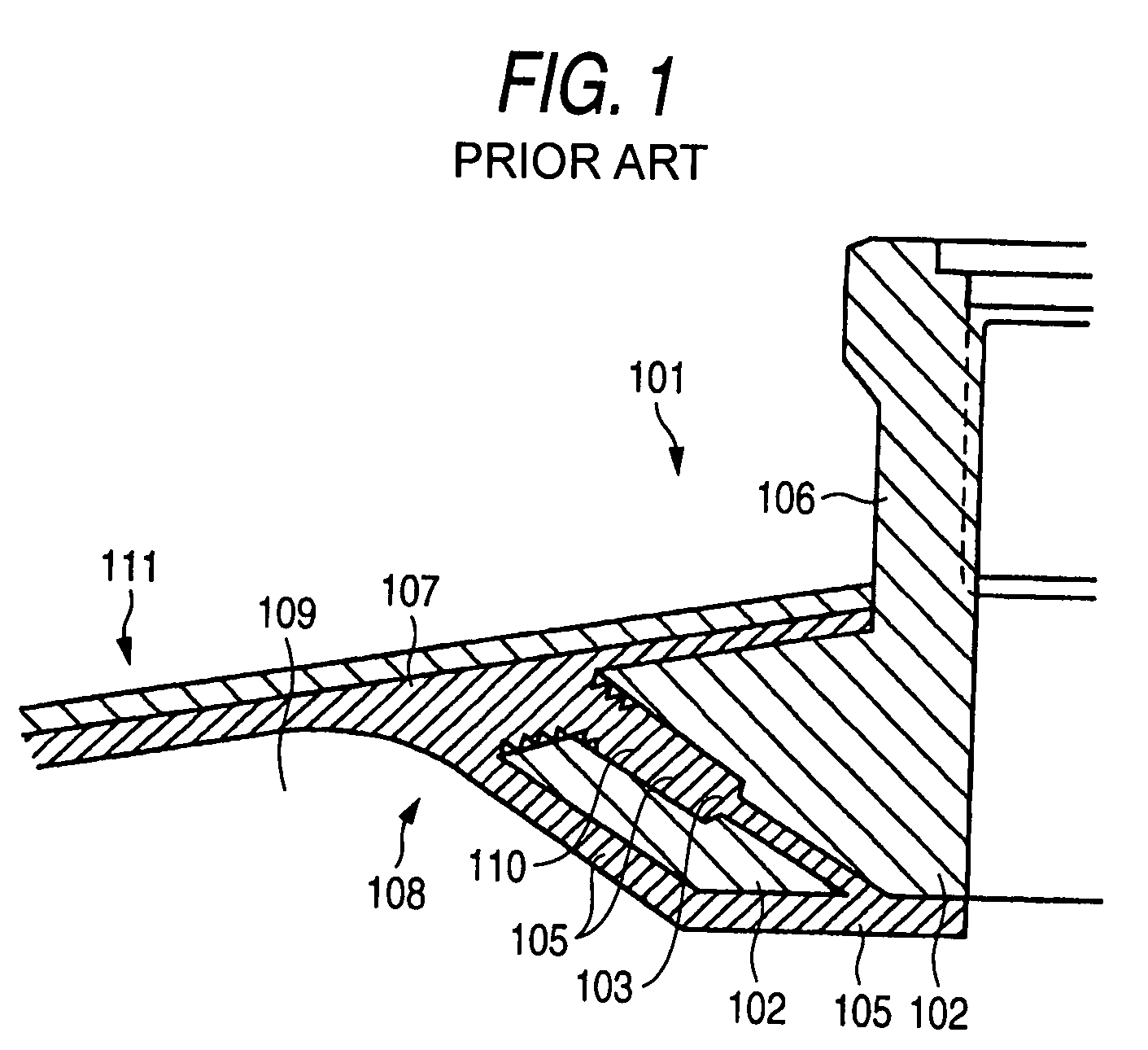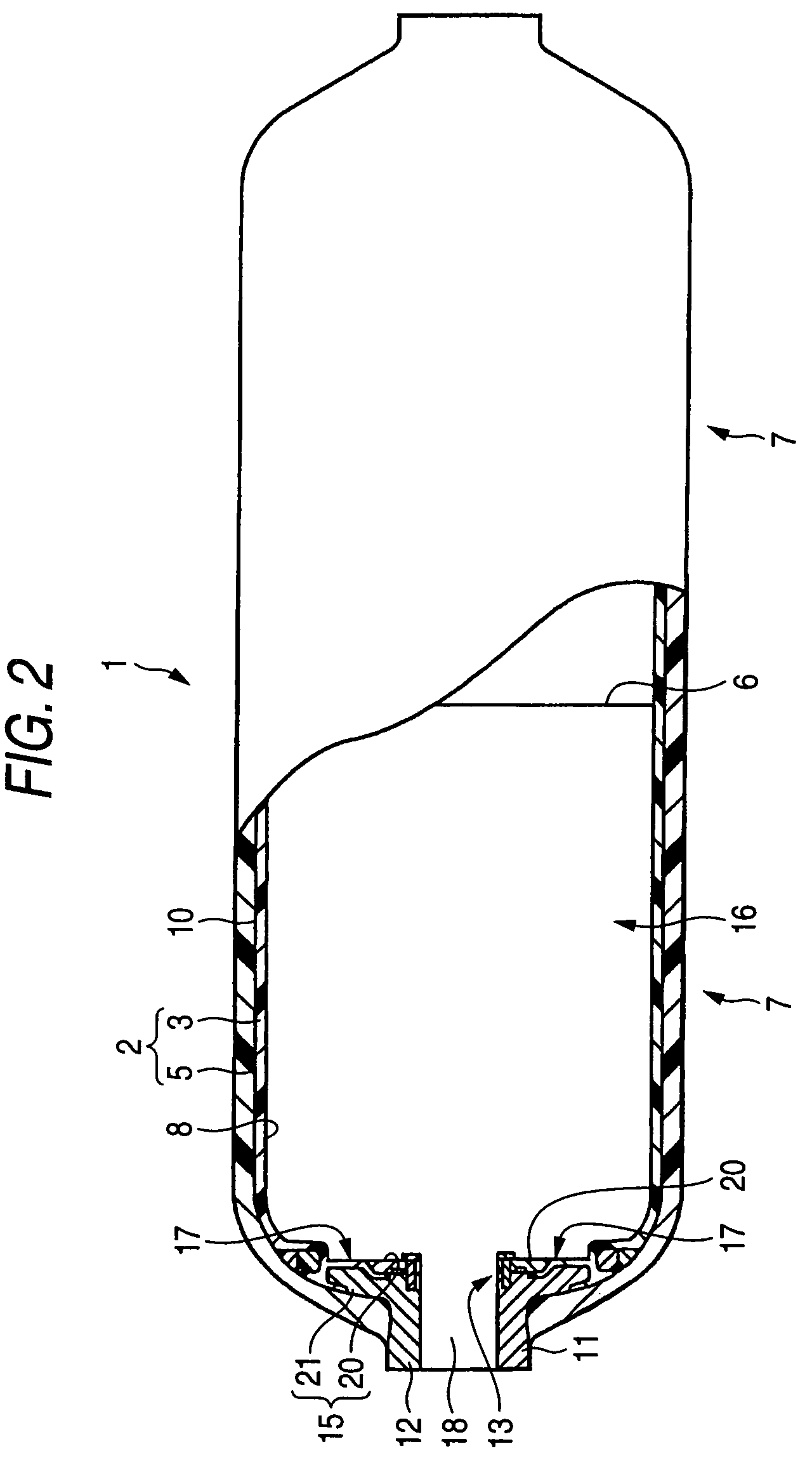Pressure container
a technology of pressure containers and pressure chambers, applied in the field of pressure containers, can solve the problems of high stress concentration in resinous liner, insufficient sealing ability of pressure containers, and thereby broken or damaged liner, and achieve the effect of improving sealing ability
- Summary
- Abstract
- Description
- Claims
- Application Information
AI Technical Summary
Benefits of technology
Problems solved by technology
Method used
Image
Examples
embodiment 1
[0088]Embodiment 1 is to demonstrate a pressure container which has a ring-shaped constraint member around the self-sealing part and in the outer periphery of the liner and has an easily-displaceable part 37 on the outer periphery of the self-sealing part of the liner in the radial direction thereof. FIG. 2 shows a schematic cross-sectional view of the pressure container of Embodiment 1; and FIG. 3 is a partly-enlarged view of FIG. 2.
[0089]Of the pressure container of Embodiment 1, the container body 2 is composed of a constraint layer 5 and a liner 3 attached on the inner surface of the constraint layer 5. The liner 3 of the container body 2 is prepared as two parts 7 of the same shape that are split at the body center 6, and the two parts 7 are hot-sealed and integrated into the liner 3.
[0090]The liner 3 is formed of PPS (polyphenylene sulfide), and this covers the inner surface 8 of the container body 2. The constraint layer 5 is formed of FRP that contains carbon fibers and epox...
embodiment 2
[0105]Embodiment 2 is to demonstrate a pressure container that is fabricated in the same manner as in Embodiment 1 except that the constraint member is embedded in the liner and is integrated with the liner. FIG. 4 is a partly-enlarged, schematic cross-sectional view of the pressure container of Embodiment 2.
[0106]In the pressure container 40 of Embodiment 2, the constraint member 41 is embedded in the liner 42 and is integrated with the liner 42. Therefore, the process for producing the pressure container in this Embodiment may be simplified. In addition, like in Embodiment 1, the pressure container of this Embodiment also has the constraint member 41 and the easily-displaceable part 43, and therefore the bonding between the self-sealing part 45 and the flange 46 in this is also kept good.
embodiment 3
[0107]Embodiment 3 is to demonstrate a pressure container that is the same as that of Embodiment 1 except that the constraint member is integrated with the constraint layer and the flange is the flange body alone. FIG. 5 is a partly-enlarged, schematic cross-sectional view of the pressure container of Embodiment 3.
[0108]In the pressure container 47 of Embodiment 3, the flanges 52 is the flange body 44 alone, and the flange body 44 is processed to have a groove 39 in the circumferential direction thereof. In the pressure container 47 of this Embodiment 3, a part of the self-sealing part 51 is formed to be filled inside the groove 39, and therefore the self-sealing part 51 is held by the groove 39.
[0109]In the pressure container 47 of Embodiment 3, the constraint member 48 is integrated with the constraint layer 49. Therefore, the process for producing the pressure container in this Embodiment may be simplified. In addition, like in Embodiment 1, the pressure container of this Embodim...
PUM
| Property | Measurement | Unit |
|---|---|---|
| Pressure | aaaaa | aaaaa |
| Diameter | aaaaa | aaaaa |
| Impact resistance | aaaaa | aaaaa |
Abstract
Description
Claims
Application Information
 Login to View More
Login to View More - R&D
- Intellectual Property
- Life Sciences
- Materials
- Tech Scout
- Unparalleled Data Quality
- Higher Quality Content
- 60% Fewer Hallucinations
Browse by: Latest US Patents, China's latest patents, Technical Efficacy Thesaurus, Application Domain, Technology Topic, Popular Technical Reports.
© 2025 PatSnap. All rights reserved.Legal|Privacy policy|Modern Slavery Act Transparency Statement|Sitemap|About US| Contact US: help@patsnap.com



